University Name: Business Level Strategy Report - MGMT Module
VerifiedAdded on 2022/08/31
|5
|870
|24
Report
AI Summary
This report delves into the realm of strategic management, specifically focusing on business-level strategies and competitive advantage within a global context. It meticulously examines Porter's generic competitive strategies, including cost leadership, differentiation, and focus strategies, illustrating their application with real-world examples like Unilever, Four Seasons Hotels, and Haagen Daz. The report explores the advantages and risks associated with each strategy, emphasizing the importance of aligning the value chain to support the chosen strategy. Furthermore, it addresses the concept of 'Stuck in the Middle' (SIM) and the potential for hybrid strategies, exemplified by IKEA's approach. The analysis underscores the critical role of core competencies in sustaining competitive advantage and offers valuable insights for effective strategic decision-making.
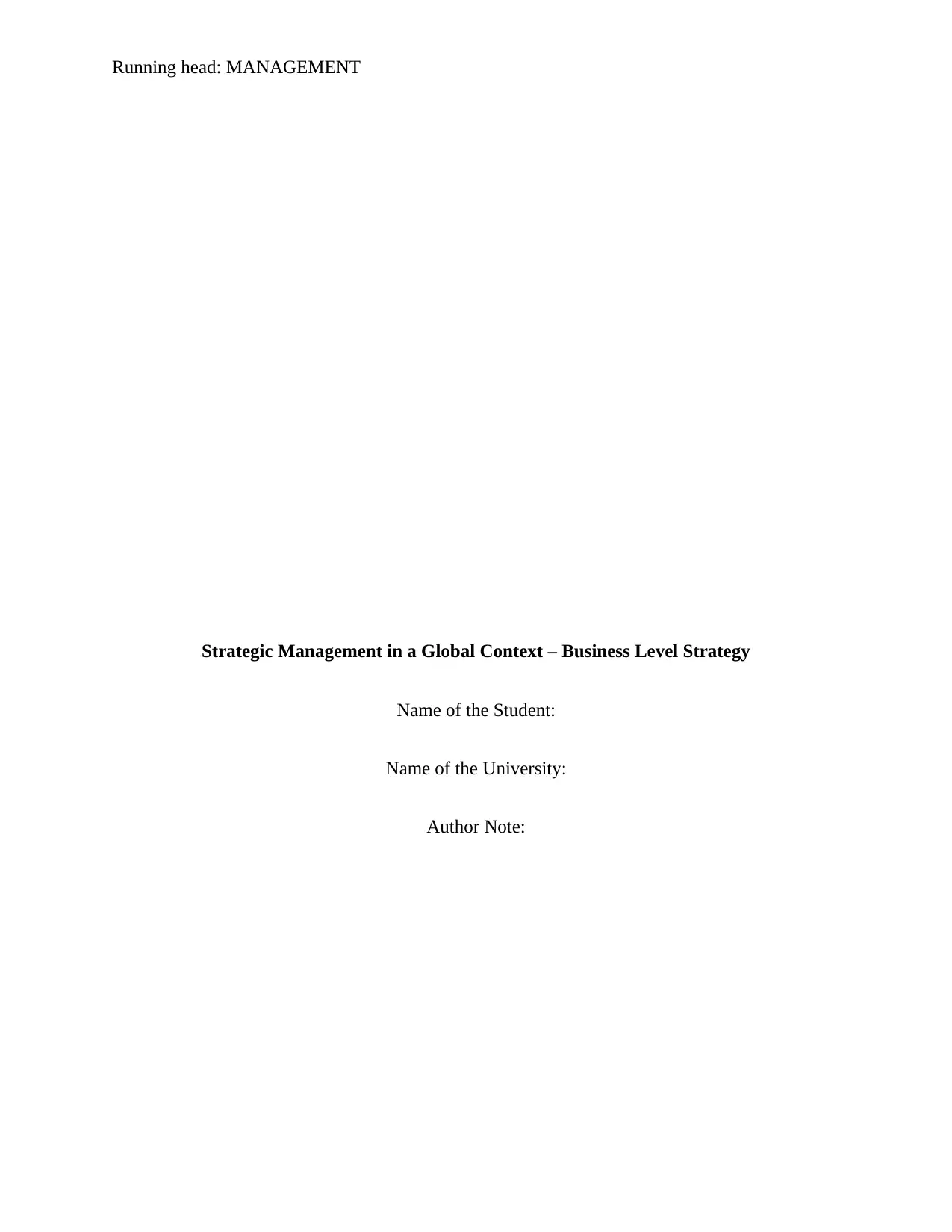
Running head: MANAGEMENT
Strategic Management in a Global Context – Business Level Strategy
Name of the Student:
Name of the University:
Author Note:
Strategic Management in a Global Context – Business Level Strategy
Name of the Student:
Name of the University:
Author Note:
Paraphrase This Document
Need a fresh take? Get an instant paraphrase of this document with our AI Paraphraser
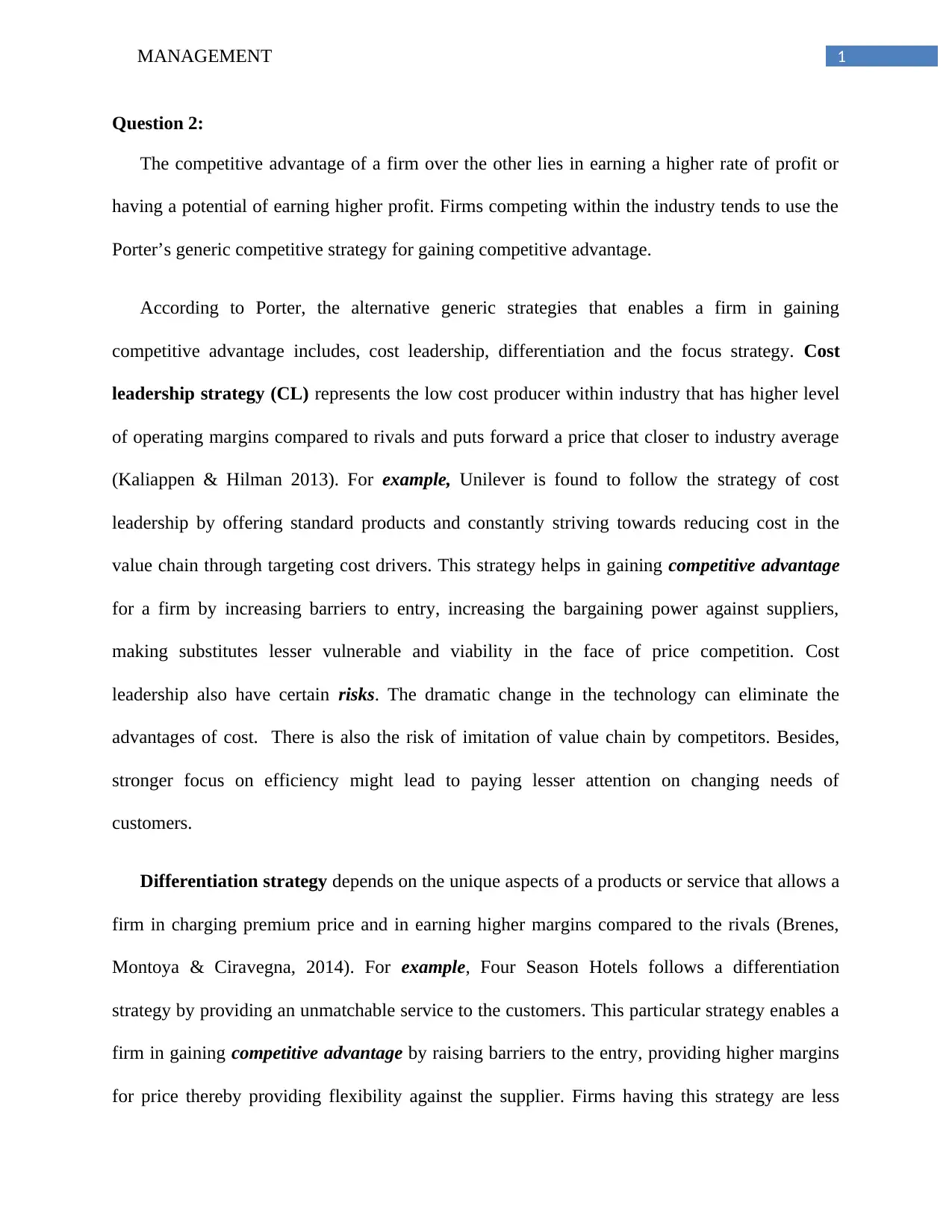
1MANAGEMENT
Question 2:
The competitive advantage of a firm over the other lies in earning a higher rate of profit or
having a potential of earning higher profit. Firms competing within the industry tends to use the
Porter’s generic competitive strategy for gaining competitive advantage.
According to Porter, the alternative generic strategies that enables a firm in gaining
competitive advantage includes, cost leadership, differentiation and the focus strategy. Cost
leadership strategy (CL) represents the low cost producer within industry that has higher level
of operating margins compared to rivals and puts forward a price that closer to industry average
(Kaliappen & Hilman 2013). For example, Unilever is found to follow the strategy of cost
leadership by offering standard products and constantly striving towards reducing cost in the
value chain through targeting cost drivers. This strategy helps in gaining competitive advantage
for a firm by increasing barriers to entry, increasing the bargaining power against suppliers,
making substitutes lesser vulnerable and viability in the face of price competition. Cost
leadership also have certain risks. The dramatic change in the technology can eliminate the
advantages of cost. There is also the risk of imitation of value chain by competitors. Besides,
stronger focus on efficiency might lead to paying lesser attention on changing needs of
customers.
Differentiation strategy depends on the unique aspects of a products or service that allows a
firm in charging premium price and in earning higher margins compared to the rivals (Brenes,
Montoya & Ciravegna, 2014). For example, Four Season Hotels follows a differentiation
strategy by providing an unmatchable service to the customers. This particular strategy enables a
firm in gaining competitive advantage by raising barriers to the entry, providing higher margins
for price thereby providing flexibility against the supplier. Firms having this strategy are less
Question 2:
The competitive advantage of a firm over the other lies in earning a higher rate of profit or
having a potential of earning higher profit. Firms competing within the industry tends to use the
Porter’s generic competitive strategy for gaining competitive advantage.
According to Porter, the alternative generic strategies that enables a firm in gaining
competitive advantage includes, cost leadership, differentiation and the focus strategy. Cost
leadership strategy (CL) represents the low cost producer within industry that has higher level
of operating margins compared to rivals and puts forward a price that closer to industry average
(Kaliappen & Hilman 2013). For example, Unilever is found to follow the strategy of cost
leadership by offering standard products and constantly striving towards reducing cost in the
value chain through targeting cost drivers. This strategy helps in gaining competitive advantage
for a firm by increasing barriers to entry, increasing the bargaining power against suppliers,
making substitutes lesser vulnerable and viability in the face of price competition. Cost
leadership also have certain risks. The dramatic change in the technology can eliminate the
advantages of cost. There is also the risk of imitation of value chain by competitors. Besides,
stronger focus on efficiency might lead to paying lesser attention on changing needs of
customers.
Differentiation strategy depends on the unique aspects of a products or service that allows a
firm in charging premium price and in earning higher margins compared to the rivals (Brenes,
Montoya & Ciravegna, 2014). For example, Four Season Hotels follows a differentiation
strategy by providing an unmatchable service to the customers. This particular strategy enables a
firm in gaining competitive advantage by raising barriers to the entry, providing higher margins
for price thereby providing flexibility against the supplier. Firms having this strategy are less
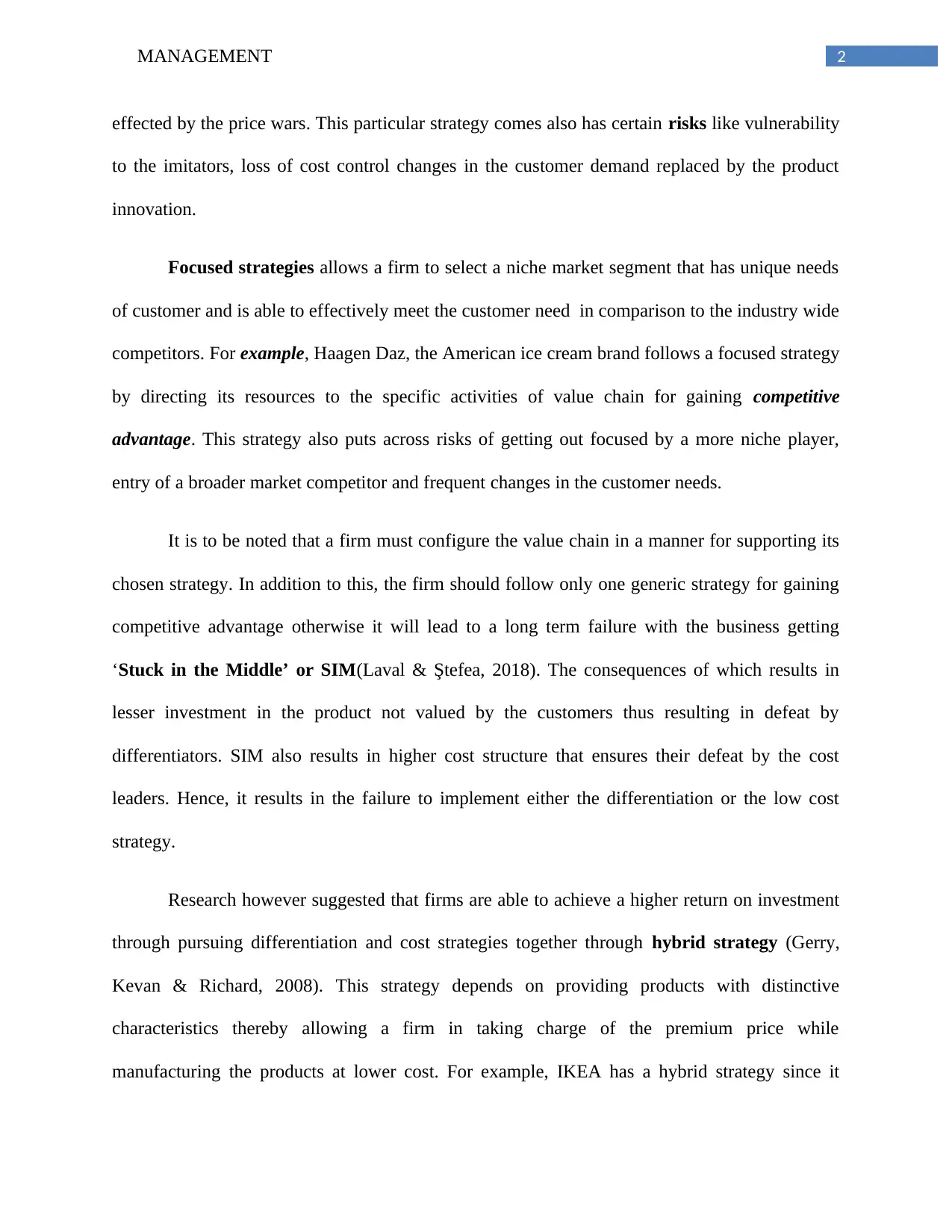
2MANAGEMENT
effected by the price wars. This particular strategy comes also has certain risks like vulnerability
to the imitators, loss of cost control changes in the customer demand replaced by the product
innovation.
Focused strategies allows a firm to select a niche market segment that has unique needs
of customer and is able to effectively meet the customer need in comparison to the industry wide
competitors. For example, Haagen Daz, the American ice cream brand follows a focused strategy
by directing its resources to the specific activities of value chain for gaining competitive
advantage. This strategy also puts across risks of getting out focused by a more niche player,
entry of a broader market competitor and frequent changes in the customer needs.
It is to be noted that a firm must configure the value chain in a manner for supporting its
chosen strategy. In addition to this, the firm should follow only one generic strategy for gaining
competitive advantage otherwise it will lead to a long term failure with the business getting
‘Stuck in the Middle’ or SIM(Laval & Ştefea, 2018). The consequences of which results in
lesser investment in the product not valued by the customers thus resulting in defeat by
differentiators. SIM also results in higher cost structure that ensures their defeat by the cost
leaders. Hence, it results in the failure to implement either the differentiation or the low cost
strategy.
Research however suggested that firms are able to achieve a higher return on investment
through pursuing differentiation and cost strategies together through hybrid strategy (Gerry,
Kevan & Richard, 2008). This strategy depends on providing products with distinctive
characteristics thereby allowing a firm in taking charge of the premium price while
manufacturing the products at lower cost. For example, IKEA has a hybrid strategy since it
effected by the price wars. This particular strategy comes also has certain risks like vulnerability
to the imitators, loss of cost control changes in the customer demand replaced by the product
innovation.
Focused strategies allows a firm to select a niche market segment that has unique needs
of customer and is able to effectively meet the customer need in comparison to the industry wide
competitors. For example, Haagen Daz, the American ice cream brand follows a focused strategy
by directing its resources to the specific activities of value chain for gaining competitive
advantage. This strategy also puts across risks of getting out focused by a more niche player,
entry of a broader market competitor and frequent changes in the customer needs.
It is to be noted that a firm must configure the value chain in a manner for supporting its
chosen strategy. In addition to this, the firm should follow only one generic strategy for gaining
competitive advantage otherwise it will lead to a long term failure with the business getting
‘Stuck in the Middle’ or SIM(Laval & Ştefea, 2018). The consequences of which results in
lesser investment in the product not valued by the customers thus resulting in defeat by
differentiators. SIM also results in higher cost structure that ensures their defeat by the cost
leaders. Hence, it results in the failure to implement either the differentiation or the low cost
strategy.
Research however suggested that firms are able to achieve a higher return on investment
through pursuing differentiation and cost strategies together through hybrid strategy (Gerry,
Kevan & Richard, 2008). This strategy depends on providing products with distinctive
characteristics thereby allowing a firm in taking charge of the premium price while
manufacturing the products at lower cost. For example, IKEA has a hybrid strategy since it
⊘ This is a preview!⊘
Do you want full access?
Subscribe today to unlock all pages.

Trusted by 1+ million students worldwide
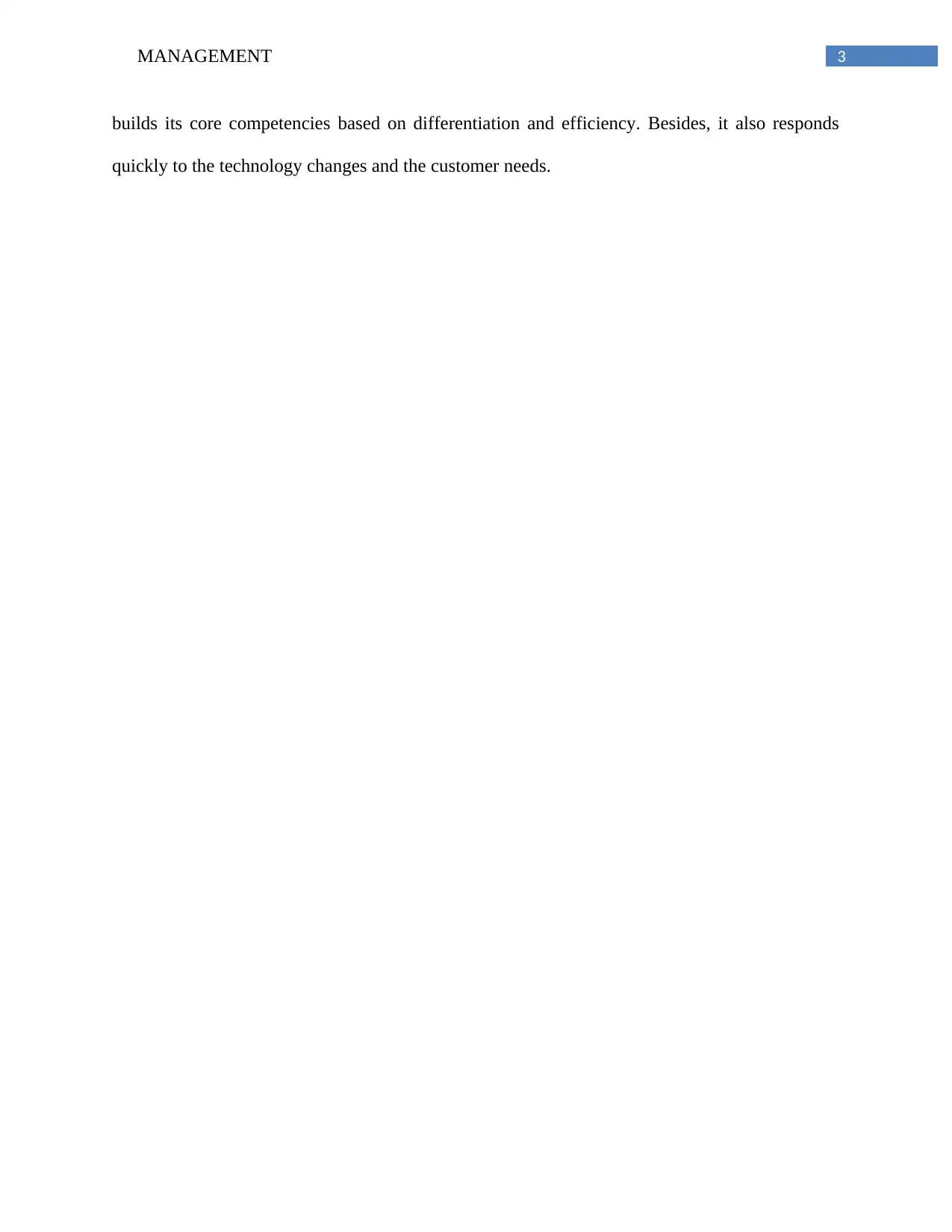
3MANAGEMENT
builds its core competencies based on differentiation and efficiency. Besides, it also responds
quickly to the technology changes and the customer needs.
builds its core competencies based on differentiation and efficiency. Besides, it also responds
quickly to the technology changes and the customer needs.
Paraphrase This Document
Need a fresh take? Get an instant paraphrase of this document with our AI Paraphraser
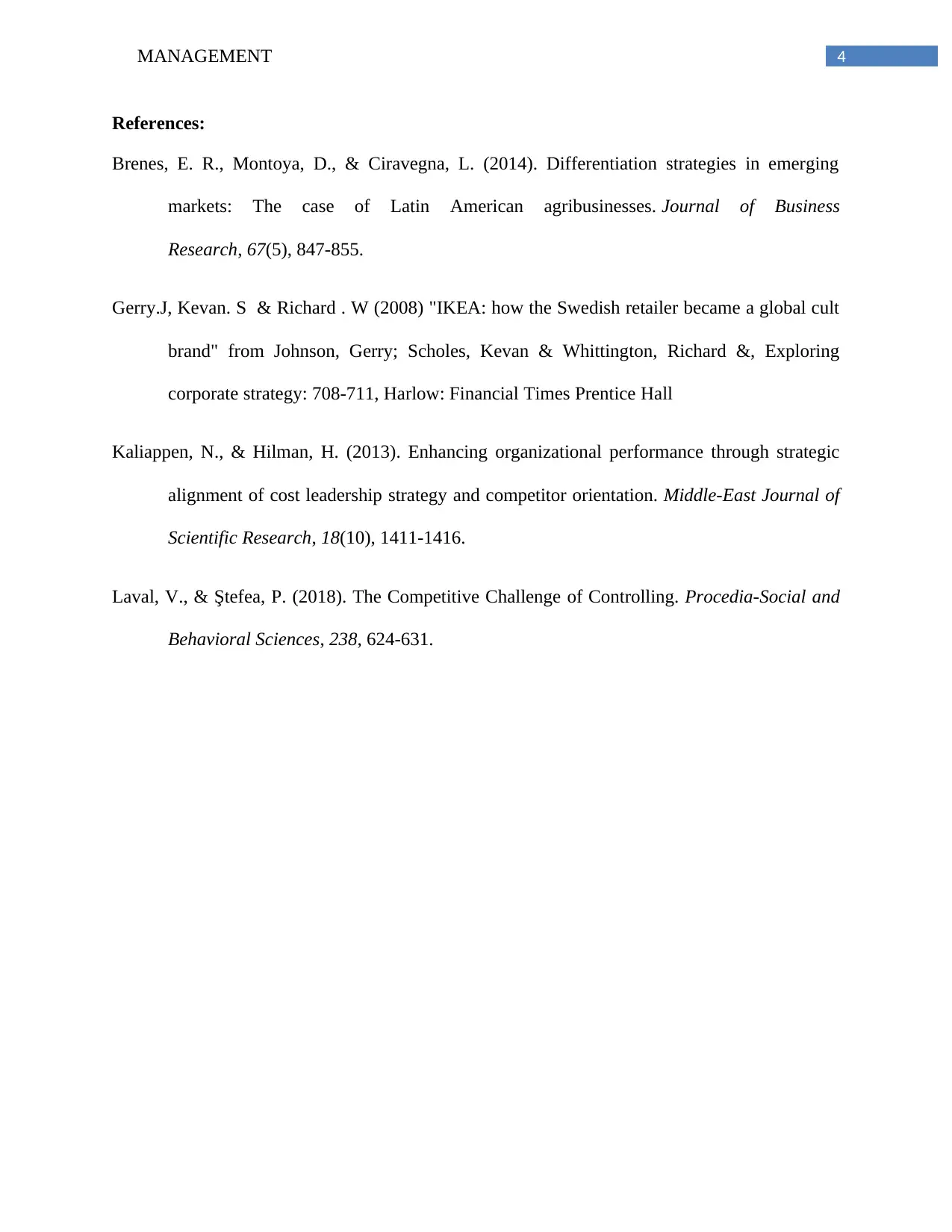
4MANAGEMENT
References:
Brenes, E. R., Montoya, D., & Ciravegna, L. (2014). Differentiation strategies in emerging
markets: The case of Latin American agribusinesses. Journal of Business
Research, 67(5), 847-855.
Gerry.J, Kevan. S & Richard . W (2008) "IKEA: how the Swedish retailer became a global cult
brand" from Johnson, Gerry; Scholes, Kevan & Whittington, Richard &, Exploring
corporate strategy: 708-711, Harlow: Financial Times Prentice Hall
Kaliappen, N., & Hilman, H. (2013). Enhancing organizational performance through strategic
alignment of cost leadership strategy and competitor orientation. Middle-East Journal of
Scientific Research, 18(10), 1411-1416.
Laval, V., & Ştefea, P. (2018). The Competitive Challenge of Controlling. Procedia-Social and
Behavioral Sciences, 238, 624-631.
References:
Brenes, E. R., Montoya, D., & Ciravegna, L. (2014). Differentiation strategies in emerging
markets: The case of Latin American agribusinesses. Journal of Business
Research, 67(5), 847-855.
Gerry.J, Kevan. S & Richard . W (2008) "IKEA: how the Swedish retailer became a global cult
brand" from Johnson, Gerry; Scholes, Kevan & Whittington, Richard &, Exploring
corporate strategy: 708-711, Harlow: Financial Times Prentice Hall
Kaliappen, N., & Hilman, H. (2013). Enhancing organizational performance through strategic
alignment of cost leadership strategy and competitor orientation. Middle-East Journal of
Scientific Research, 18(10), 1411-1416.
Laval, V., & Ştefea, P. (2018). The Competitive Challenge of Controlling. Procedia-Social and
Behavioral Sciences, 238, 624-631.
1 out of 5
Related Documents
Your All-in-One AI-Powered Toolkit for Academic Success.
+13062052269
info@desklib.com
Available 24*7 on WhatsApp / Email
![[object Object]](/_next/static/media/star-bottom.7253800d.svg)
Unlock your academic potential
Copyright © 2020–2025 A2Z Services. All Rights Reserved. Developed and managed by ZUCOL.




